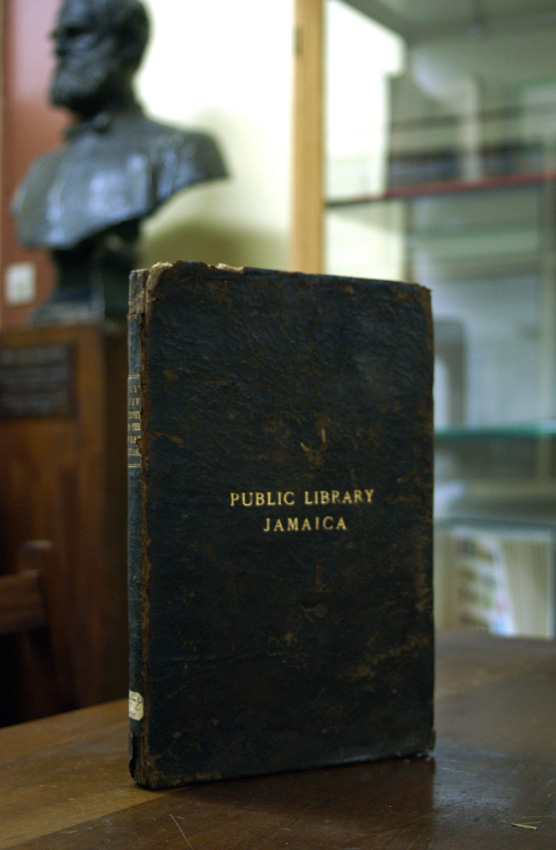Travel in Jamaica - Exploring the National Library in Downtown Kingston, in the year 2012
- by Thibault Ehrengardt

The Jamaican National Library's copy of Gage's Survey.
The preface of this worthy work of this most worthy friend the author was written by Thomas Chaloner, one of the judges who put Charles I to death in 1649. A membre of Parliament, Chaloner was responsible for the publishing of Gage’s book that he intended to use as a political tool for his master, Oliver Cromwell. After several years of civil war, Cromwell had become the Protector of the Commonwealth in 1642. Surrounded by silenced but still powerful enemies, Cromwell needed to reinforce his position through martial conquests. Spain was the best target, in both the old and the new worlds. That’s where Gage’s book came into the picture. The “most worthy author” described the magnificent Spanish cities of the New World, their wealth and their weak defences. The Spaniards, said he, never bothered to fortify their cities, being too confident in the remoteness of their settlements. In Porto Bello, piles of silver bars were left unattended in the open. It was enough to excite the imagination of any English – and to justify a sudden military action against an allied country.
Giving away his former friends was a way for Gage to prove his loyalty to Cromwell. But his family could not stand such a disgrace. His brother, then Colonel in Flanders, eventually sent someone for him. “I almost got killed in Shoe Lane by a Captain of my brother’s company”, wrote Gage who escaped the plot.
His book became an instant success. Cromwell required a memoir from him in which the English American explained why England had the right to pretend to the Spanish territories of the New World, exclusively granted to Spain by an old and unjust papal bull. The naval expedition for the West Indies was baptized the Western Design –Thomas Gage was appointed chaplain. The Western Design was bound to fail. Cromwell did not trust his Admiral (William Penn, father of the founder of Penn-sylvania) nor his General (Venables) and adjoined them a board of commissioners who did nothing but to add confusion. The expedition shamefully failed to capture the island of Hispanola in March 1655. The defeat was humiliating. Fearing the wrath of Cromwell, Penn and Venables then decided to capture the nearby island of Jamaica – as a consolation prize.
*** *** ***
The NLF copy of Gage’s travels features an anonymous map of the Yslandes of the West Indies. The figures of Jamaica are quite correct for the time – yet, Thomas Gage had never been to Jamaica. The short passage of his book dedicated to the island is obviously compiled from other books; at least he was aware of its existence. But we will never know who suggested to capture it after the defeat of Santo Domingo. All we know is that on May the 10th, 1655, the 38 vessels of the Western Design entered the Caguay Bay (Kingston Bay) to disembark their 8000 soldiers. After a short resistance, the Spaniards agreed to discuss the terms of their surrender. Thomas Gage acted as an interpreter during the negociations. The Spaniards did their best to distract the English while evacuating their riches from the main town of Santiago de la Vega (Spanish Town), arguing that they could not discuss before the end of their religious ceremonies. Gage retorted that the Lord, surrounded as He was by angels and merry souls, would excuse them for this time. And when the Spanish Governor objected that Jamaica was the legal possession of his country, our “villain” answered that only weapons decide of possession, not laws.
The Western Design was a failure and a humiliating defeat. Still, Jamaica - that remained an English possession until its independence in 1962 – was to become the richest colony of the British empire of the 18th century, thanks to sugar - that is to say, thanks to the slave trade. We do not exactly know what happened to Thomas Gage during the year he spent on the island. But in July 1656, the Council of State organized the payment of some debts it had contracted towards him, to his wife Mary Gage. He must have died a few weeks ago, in Jamaica - from dysentery. No one knows where he was buried - if he ever was. Nothing remains in Jamaica to testify of the influence of this “villain” on the history of the island... apart from a rubbed book in the National Library.
*** *** ***